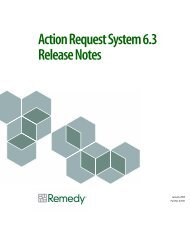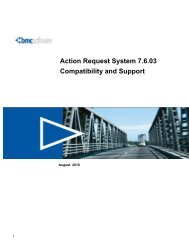BMC Remedy Action Request System 7.6.04: BMC Remedy Mid Tier ...
BMC Remedy Action Request System 7.6.04: BMC Remedy Mid Tier ...
BMC Remedy Action Request System 7.6.04: BMC Remedy Mid Tier ...
You also want an ePaper? Increase the reach of your titles
YUMPU automatically turns print PDFs into web optimized ePapers that Google loves.
Values<br />
Using the advanced search bar<br />
Enclose nonnumeric values (including time, selection, and currency values) in<br />
double quotation marks (for example, “07/01/08” for July 1, 2008).<br />
Selection field values<br />
Selection field values can be specified as text values in quotation marks or numeric<br />
values or indexes not in quotation marks. For example, if you have a Status field<br />
with the option buttons labeled Open, Fixed, and Verified, you can enter either<br />
“Open” or 0 to specify the value of Open, because Open is the first selection value<br />
in the selection field.<br />
Currency field values<br />
For currency fields, use the Currency Codes submenu to choose an available<br />
currency code. When you choose a currency code, the double quotation marks are<br />
automatically entered (such as “USD"). Add the currency value within the double<br />
quotation marks (for example, “100 USD").<br />
If you do not specify a currency code, the primary allowable currency type is<br />
assumed.<br />
Using relational operators in the advanced search bar<br />
Relational operators are useful especially in nontext fields (such as date and time<br />
fields) when you want to search for a value within a numerical range.<br />
You can use the following relational operators only in the advanced search bar.<br />
You cannot use them in a form. See Using relational operators in a search.<br />
Table B-4: Operators (Sheet 1 of 3)<br />
Operator <strong>Action</strong><br />
( ) Use parentheses to control the order in which the expression is carried<br />
out. Operations found within parentheses are executed together as a<br />
unit.<br />
For example, in the operation ’Gross Income’ ñ (’Unemployment<br />
Insurance’ + ’Pension Plan Contributions’ + ’Income Tax’) ,<br />
the items within the parentheses are added before they are subtracted<br />
from Gross Income.<br />
AND && Logical AND of the result of two conditions. The result is true only if both<br />
conditions are true. For example, ’Status’="New” AND ’Assigned<br />
to’="Andy” finds all new requests assigned to Andy.<br />
You can use two ampersands (&&) instead of the word AND.<br />
OR || Logical OR of the result of two conditions. The result is true if either<br />
condition is true. For example, ’Status’="New” OR ’Assigned<br />
to’="Andy” finds all new requests (regardless of who they are assigned<br />
to) and all requests assigned to Andy (no matter what their status).<br />
You can use two vertical lines (||) instead of the word OR.<br />
Appendix B For your end users: Running and saving searches on the Web 147





